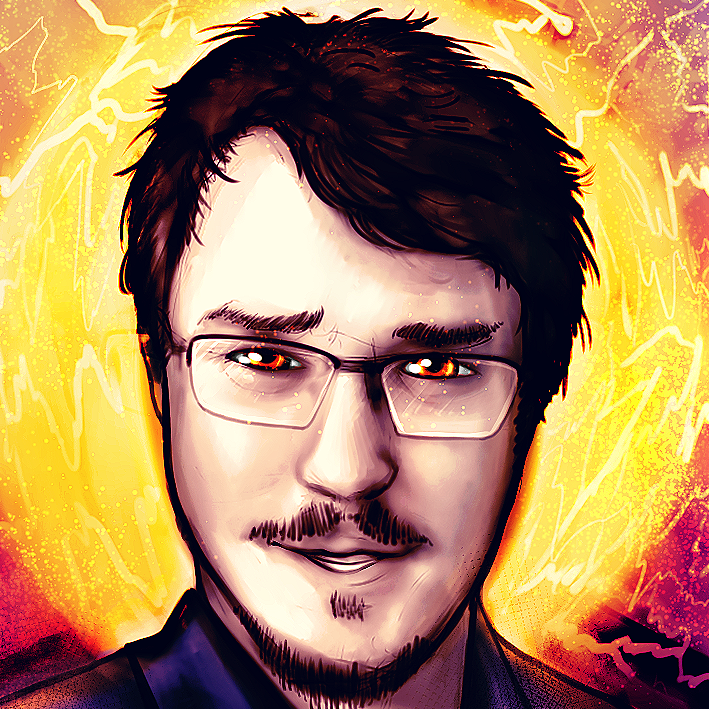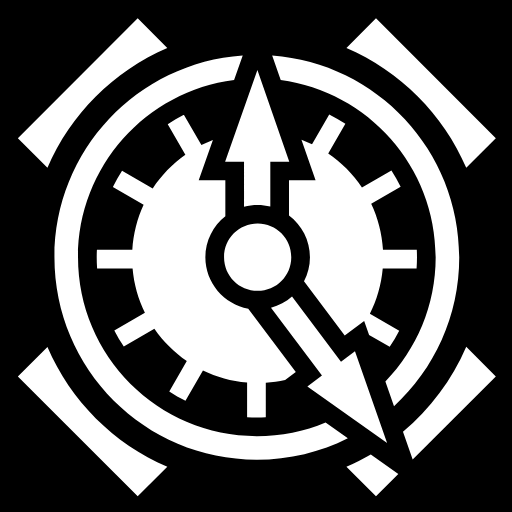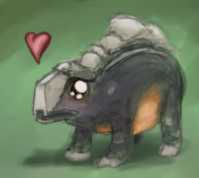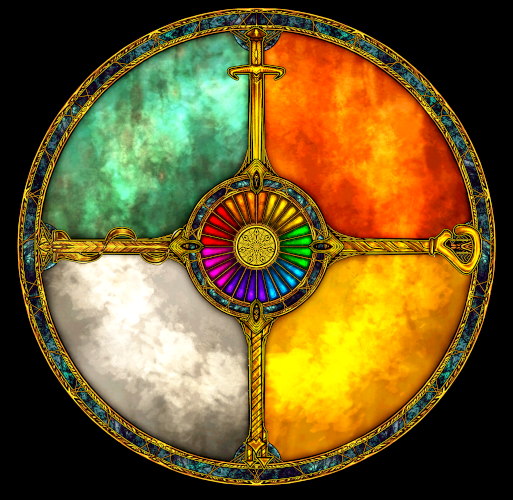Biography
Rise to Emeri Sau-Kenda
Kyzan was born in 6381 to a large tribe in the northern vertebrae of the Lukradean Spine mountain range. Harsh conditions and the demanding culture of his people had him working from a young age.
He was the youngest son of the village Emeri (shaman), an upbringing which meant having to learn the runes used to write their calendar, history, myths, herd migrations, and everything else an emeri was charged with tracking. As the youngest son, he was not expected to take over as emeri when he grew up, he was trained in the critical features should his parents and elder siblings die, and then was instead raised to be a hunter and warrior.
Kyzan excelled as a hunter. He was raised in a time that was fruitful for his tribe, and so grew tall, strong, and keen. As with most Verin hunters of the time, Kyzan was expected to learn the basics of falconry. He took to it passionately, drawn to it by his emeri upbringing, and soon moved on to managing a raptor of his own.
These three elements—emeri, warrior, and falconer—combined to make Kyzan a force to be reckoned with. When Amir and Sauthei tribes, hungry for his people’s rich lands, began to push the borders he took up a personal vendetta against them and pushed back. He wrote new runes with his family, and while away from his village carved these new runes onto stones and had his raptos carry them back and forth between his tribe to relay to his Kenda (chief) the progress of raids and the movements of other tribes. This method of communication, obvious to us today, was unprecedented at the time, and made his tribe extremely versatile and effective.
Over the course of years he pushed this advantage, driving the Amir and Sauthei back into their own lands. His kenda charged him with wiping them out entirely—a task he took to with zeal. He grew ambitious, tired of the old ways, and before long he challenged his kenda for control of the tribe. He was tired of surviving, he wanted to thrive, to build an empire.
In the year 6442, Kyzan defeated his kenda in ritual combat and assumed his mantle.
In the year 6477, Kyzan became kenda of the Lukdradean Spine.
By the year 6522, Kyzan’s rule had spread to the entire north. His empire was the first. He had taken the north slowly and methodically by killing the raptors of his rivals, poaching from their hunting grounds so that they had to choose between letting their prey breed or feeding on them, and assassinating their hunting parties before finally approaching their tribe and offering mercy for submission. By ritual combat he won fight after fight, and the particularly obstinate found themselves executed by Red Baptism, an ancient and brutal method of execution among the Faeo.
Kyzan took many wives and sired many children. To this day there isn't a Faeo or Faecha whose veins do not pump with the blood of Kyzan, whose eyes don’t have some glimmer of his fire.
Kyzan appointed kenda from his tribe, sired by his own loins, or sired of the loins of his tribesmen. His reign of the north was total. He became known as Emeri Sau-Kenda. The Shaman High Chief.
There is one law. Violence.
— Kyzan
As Emeri Sau-Kenda
With uncontestable control of the north behind him, Kyzan turned his gaze southwards. With much the same tactics employed in taking the north he began to push through the Sauthei and Amir lands, and even managed to reach as far as the borders of the Chea Clansreach before the Chea reached out to the Sauthei and Amir to organize against him.
In 6538 they each chose one kenda among them and named him Sau-Kenda of their people. They did this by process of vote or contest, and in the end these three became the azukenda—the Three Kenda.
The azukenda organized to have each tribe build and maintain manned palisades against Kyzan’s Front, staunching a direct approach into the lands and flushing any infiltrators into disadvantageous terrain which put them at the mercy of the superior bronze weaponry of the Chea, who also were comfortable with a direct attack tactic as Kyzan’s warriors used. In the combined forces of the azukenda Kyzan at last met his match.
By the year 6560, the azukenda forces had so staunched Kyzan that they began to push back against the border of his influence, taking back tribal grounds and repopulating them with people of their own. By 6579 the azukenda had broken the emeri code Kyzan had trained to all of his falconers, adapted it for their own use, and had utterly shattered his advantage. They pushed him back as far as the Lukradean Spine at a pace of advancement unprecedented for the time.
Rise to Sovereign
The azukenda army arrived in the Lukradean Spine in 6580, boxing Kyzan in on every side and forcing him to retreat into the depths of the mountains. His army put up a worthy battle, holding the azukenda at bay for five days before finally getting subdued. Most were killed, but Kyzan and several dozen of his warriors were captured. His warriors were tied to crosses and made to watch as Kyzan was executed in the Amir ritual of the Raptor Feast.
His men were forced to watch as the Amir raptors descended on the tied-prostrate form of Kyzan and ate him alive slowly, tearing away at his tender flesh before digging into the deeper meats. It would have taken him hours to die that way, and even after that it is said that his men were forced to watch his corpse bloat and gather flies, that if they slept they were cut by azukenda warriors until they woke again. They were to be left to make their way home, to carry their broken spirits back to their people and to undermine the resistance of the remaining Kyzan-loyal tribes.
Then the Wheel intervened.
The azukenda leaders left on the second day.
On the fourth day he rose from the dead, screaming, animated by sheer will rather than by the pumping of blood. He had returned from death, the first ever to do so, and upon his brow burned a glowing ring. It is said that his words weren’t heard, but they were understood by all present all the same.
I have died, looked into the eye of creation, and returned. The Wheel spoke a single truth. Violence. This world is Violence, and I am its Sovereign.
— Kyzan
It is a testament to Kyzan's strength that even in death he would destroy his enemies. In fact, one of the greatest mysteries in our known universe is why of all men the Wheel chose him. Some would say it was inspired by his resolve, some that it was impressed by his wisdom. More still believe that he refused so wholeheartedly to be recycled that it gave him the power to see how he would use it. Not a one of us can deign to know the will of the Wheel, though if we are to believe the tale of Kyzan, it is violence. Who better to carry out that will than Kyzan himself?
— Esren
Though his muscles were rotting and half-stripped, Kyzan rose. Without a blade he cut down the lingering azukenda warriors. His screams froze their blood in their veins, his hatred turned them to ash—with a sweep of his hand he gutted them from neck to crotch. He had returned from death with the power to the Wheel in his hand and on his brow. Metaphysics was awakened.
Of course at the time it must have been incredible, but such power and demonstrations of metaphysics are fairly commonplace today.
— Human scholar
What was supposed to break Kyzan’s warriors instead cemented their loyalty. They returned to their tribes at his word, and among their people spread loyalty to his cause. He proved himself by visiting each tribe, by demonstrating his undying state by appearing before them as nothing more than spirit and bone. The spirit of the Faeo burned bright, and they united behind Kyzan.
War was brewing.
Founding the Kyzanate
Kyzan's return from the grave galvanized him. He no longer had the cravings of the flesh—for meat and mead and maidens—and so his hunger for power filled the void. It was not enough to rule the Faeo, he had to rule the world. He felt this was the right granted by the Wheel, that the mark of it upon his brow named him Sovereign of all things burning under the Wheel, under the sun.
I am the one and only King, the Sovereign ruler of the earth underfoot and the seas all around. So says the Wheel— Kyzan
Kyzan drew together his forces and all the
kenda of his remaining tribes and he brought them together under a common tribe name. The
Kyzanate. He ordered that they treat him as god, and they did. They dug their heels into the earth, and fought the
azukenda.
Kyzan’s old tactics had become common place, but his power was so great that few could bear to face him in battle. He could sunder palisades with a single spell, and so his march was unbroken. He could summon fell winds of hot and cold, and so his rivals’ crops withered. He could project his thoughts as voice over many leagues, and so could command his army with remarkable speed. It took him a long while to learn his power and each new development made him more bold, more likely to rush into a battle alone and to emerge alone.
Again he took tribes, this time with brutality and ferocity.
Kyzan gave his three generations of offspring reign of the world. They salted the fields and seeded the women, they carved his name into every stone and stacked those stones up in fortress monuments to his dominance. Some of those fortresses still stand today, the hearts of great cities.
In the year 6673 Kyzan finally cut deep enough through the
azukenda territory to corner the
azukenda themselves in a fortress, as they had once done to him, and he was able to capture them. He brought them to where the surrendered tribes congregated and publicly executed them.
For daring to stand against him, Kyzan prolonged their deaths in a manner which mocked the execution rite of their peoples.
For the Sau-Kenda of the Amir, a people which considered themselves the masters of falconry and who thus performed the Raptor Feast as their execution rite, Kyzan had his raptor eat the soft tissue of his body before performing a Red Baptism on him using the blood of his slain, prize raptor.
For the Sau-Kenda of the Sauthei, a people who considered themselves the masters of the land and who thus performed the Green Bite as their execution rite, Kyzan drained the blood of his firstborn (one of the warriors protecting him) into a basin, suspended him by his ankles until his mouth was just above the blood, and bound him in thorn whips until his exsanguination raised the level of the basin enough for him to drown by Red Baptism.
For the Sau-Kenda of the Chea, a people who considered themselves the great smelters and who thus performed the Bronze Kiss as their execution rite, Kyzan filled a furnace pot with molten bronze, drowned him in it, and quenched the metal into a solid block with the blood of his top warriors.
— Faeo Scholar
When his rivals heard of this atrocity, they were broken.
The world submitted to the iron fist of
Kyzan Yuun-Kenda—Kyzan Sun Chief.
The Amir Genocide
The Kyzanate grew over the course of a hundred and twenty years to include all of the known world of their island-continent and to envelope nearly every tribe. Only tribes which clung to the difficult points of the map were left to their own, and so it was in those places where those who still stood against the Kyzanate hid.
The last act of one these resistance tribes before falling quiet in their hiding places was for them to spread word of a curse upon the blood of Kyzan, to tell him that his bloodline would thin with time, that it would weaken. It was known to be the new
Amir Sau-Kenda saying this, their previous
Sau-Emeri.
This prophecy came true after a fashion. In the era before genetics were even known about or understood, the sudden explosion of
SelVerin (mixed-blood Verin who are much smaller and more frail than their
SoVerin—Pureblood—counterparts) reinforced the notion of an Amir curse in Kyzan’s paranoid mind.
In 6805 Kyzan declared a genocide on the Amir people, and swept the Kyzanate into such a panic that friend betrayed against friend and brother turned against brother. He claimed that it was ultimately the Amir behind so much of the bloodshed that had occured over the last 300 years, perhaps longer, and that they were weakening the people of the Kyzante with weak-blooded children—the
SelVerin.
The genocide proved more difficult than expected, but over the course of 100 years the Kyzanate methodically hunted down and killed every Amir. In the year 6906 Kyzan found the
Sau-Kenda of the Amir, she who originally cursed them, and performed the Red Baptism on her.
33 years later, in the year 6939, the Amir genocide ends, successful.
The Blood Edict
In 7238 Kyzan came to understand that the
Selverin births of the impure-bloods was caused by the interbreeding of Verin rather than by any Amir curse, Kyzan summoned his Sages and had them transcribe his rules of the Blood Edict.
- No Selverin shall be allowed to be born.
- A Verin shall lie only with his own kind.
- The Eldest Male shall rule the home.
- The Eldest Family is the most pure.
— The Blood Edict
"It is a testament to Kyzan's cruelty that he wrote the Blood Edict... But also his wisdom."— Allarah
Kyzan ordered that all
SelVerin be killed and that all Verin interbreeding come to a cease. Thus began the darkest time of the Kyzanate, when Kyzan’s troops dug his own people out of their homes and executed them publicly by Red Baptism. Talk of revolt was spoken of behind closed doors, but nobody knew how to kill Kyzan. Time had taken a toll on his bones but his spirit lingered, unfazed by the damage. How were they to vanquish him?
In secret, as his power and magic and madness ever grew, a secret group formed among his Sages, calling themselves the Hidden Legion. They were the
emeri who had had long ago tasked with recording his deeds and thoughts, and through him began to inadvertently learn of his power and how it worked, and to discover that control of the Meta was not limited to him. Slowly, and with some loss of their numbers, they learned how to cast spells, and came to realize that Kyzan could be killed.
The Hidden Legion toiled in secret, helping
Selverin such as the Faecha organize onto ships to sail for distant, unexplored lands. They continued to grow in number and strength, and to plot their overthrow of the Kyzanate.
Final Rest
In the year 7412 the hand of the Hidden Legion was forced. Kyzan caught wind of them and began to track them down, and during a grandmoot with all of his top men it became clear to the Hidden Legion that their leaders had been discovered. They revealed themselves and attacked Kyzan and his loyalists.
Never had I seen such an incredible display of power as on that night. We pushed Kyzan to his limits, and he pushed ours. I saw my brother turned half to ice and half to ash. I saw my son reduced to pulp before bursting out in all directions. I heard Kyzan’s last bones splinter. I saw his soul dwindle out.— Account of Kheren, final leader of the Hidden Legion
Of their hundred measure only seven survived, but Kyzan at last was dead. The survivors plucked the light of the Wheel from his brown, and from their number determined which would bear that crown of power upon their brow next.
The world let out a sigh of relief, and a new tale began.
Legacy
Kyzan’s actions have resonated throughout history in ways that can be traced even fourteen-thousand years after his death. Debates about him are as undying as the aftermath of his actions, and so the controversy around him rages on.
Whether you celebrate or condemn his actions, you'd be foolish to disagree with the belief that Kyzan is the single-most pivotal figure in the history of all of Ethnis. Yes, even for the humans. He was the first among many things: Tyrant, Sophont, Historian, Undead, Psiolic, Sovereign. Was he wicked? Certainly. But he was a product of his time, he was necessary.— Esren, Faeo Scholar
Kyzan was a monster, pure and simple. It's been over fourteen-thousand years since he died and still you see his touch wherever you look. It's in the arrogance and hate of the Verin, it's in the oppression of our people, it's in the creation of that loathsome shadow which plagues the stars: Brood. Spit on the name.— Artau, Sazashi Historian
In terms of
politics, the Blood Edict still stands today as the guiding principle of the Verin Haimarchy. It’s been rewritten many times since its inception, but the core concepts of bloodlines and family purity remain the same. Although it owes the Blood Edict to him, the democratic structure of the Haimarchy stands purposefully in direct opposition of his tyrannous style of rule, as the Verin decided to avoid ever having a tyrant again.
In terms of
war, Kyzan’s tactics have long since become obsolete but they laid the groundwork for the next era of war. Kyzan advocated for brutal direct combat rather than thrown spears. Most of his opponents didn’t know how to deal with this form of conflict, and fell easily. In order to respond to him they had to develop more direct tactics, and so the early legions and formations were born.
In terms of
metaphysics, Kyzan’s first studies (as recorded by the Sages) formed a fundamental understanding of metaphysics which may have taken thousands of years for casters to determine on their own had Kyzan not had them written down. He roughly defined the seven elements and the four skills, and made some very good guesses about the nature of the meta and how it suffuses the world.
In terms of
philosophy and
religion Kyzan poses a troubling question about the nature of the higher forces of the universe, namely God or The Wheel. If Kyzan was chosen, as is believed The Wheel does, then that higher force willfully chose a murderous man to give the power of Sovereignty to. What does this say about life?











Bloody, brutal, and beautiful! My favorite parts of this article are the creative execution rites, the tactical ingenuity he used with his raptors, and the proposed enigmas at the end. Bravo!